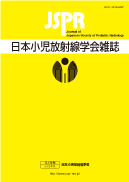Volume 37, Issue 2
Displaying 1-9 of 9 articles from this issue
- |<
- <
- 1
- >
- >|
Special Feature: The topics of the lymphangiography
-
2021Volume 37Issue 2 Pages 120
Published: 2021
Released on J-STAGE: October 29, 2021
Download PDF (474K) -
2021Volume 37Issue 2 Pages 121-126
Published: 2021
Released on J-STAGE: October 29, 2021
Download PDF (807K) Full view HTML -
2021Volume 37Issue 2 Pages 127-133
Published: 2021
Released on J-STAGE: October 29, 2021
Download PDF (5181K) Full view HTML -
2021Volume 37Issue 2 Pages 134-146
Published: 2021
Released on J-STAGE: October 29, 2021
Download PDF (9549K) Full view HTML -
2021Volume 37Issue 2 Pages 147-155
Published: 2021
Released on J-STAGE: October 29, 2021
Download PDF (3388K) Full view HTML
Original Article
-
Article type: Original Article
2021Volume 37Issue 2 Pages 156-159
Published: 2021
Released on J-STAGE: October 29, 2021
Download PDF (753K) Full view HTML
Case Report
-
Article type: Case Report
2021Volume 37Issue 2 Pages 160-165
Published: 2021
Released on J-STAGE: October 29, 2021
Download PDF (1727K) Full view HTML -
Article type: Case Report
2021Volume 37Issue 2 Pages 166-170
Published: 2021
Released on J-STAGE: October 29, 2021
Download PDF (1701K) Full view HTML
-
2021Volume 37Issue 2 Pages 171
Published: 2021
Released on J-STAGE: October 29, 2021
Download PDF (451K)
- |<
- <
- 1
- >
- >|
